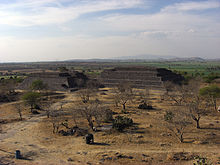History[edit]
Pre-Hispanic era[edit]
In the pre-Hispanic era, the Bajio saw the most human development due to the fertility of the soil and the presence of surface water for agriculture.[16] The oldest group to inhabit the area are called the Chupícuarios, who dominated the center of the Bajío area and were active in between 800 BCE and 300 CE.[66][76] Their largest city is now the site called Chupícuaro, and their influence was widespread being found in the modern states of Zacatecas, Querétaro, Colima, Nayarit, Hidalgo, State of Mexico, Michoacán and Guerrero. Chupícuaro cities were associated with the Toltec city of Tula and when this city fell, these agricultural cities of Guanajuato also went into decline.[66] This and a prolonged drought cause these cities to be abandonedbetween the 10th and 11th centuries with only the Guamares left ethnically.[77] Then Chichimeca and other nomadic groups entered the area. These nomadic indigenous groups are generically referred to as Chichimeca, but in reality they were a variety of ethnicities such as the Guachichiles, Pames and Zacatecos. These groups were warlike, semi nomadic and did not practice significant agriculture, nor did they construct cities.[66] Part of the state was also inhabited by the Otomi but they were mostly displaced or dominated by the Purépecha in the southwest and the Chichimeca in other parts.[77] By the 16th century, most ofMesoamerica was dominated by either the Aztec Empire or Purépecha Empire, but Guanajuato was under the control of neither. It was on the northern border of the Purépecha Empire with southern Guanajuato showing significant cultural influence in the southern valleys, and Aztecs had ventured into the area looking for minerals. However, most of the state was dominated by various Chichimeca tribes as part of what the Spanish would call the "Gran Chichimeca." These Chichimeca were mostly nomadic with some scattered agricultural communities, mostly in the north.[76]
Colonial period[edit]
As Guanajuato marks the beginning of the arid north of Mexico, at first relatively few Spanish came to settle as opposed to points south, where rainfall and indigenous labor was in much greater supply.[76] The first Spanish expedition to arrive to the Guanajuato area was led by Cristóbal de Olid in 1522 which arrived to the Yuririhapúndaro and Pénjamo areas. The discovery of silver and gold in the area of the city of Guanajuato spurred Spanish settlement of the area in the 1520s and 1530s.[78] When the Spanish did arrive, native tribes retreated to the most inaccessible areas of the Bajío and mountains ranges in the state, resisting the invaders, attacking settlements and travelers along the routes that connected Spanish settlements and mining camps. Unlike the more settled indigenous peoples, the Spanish were unable to force the natives of this area to work and brought African slaves and indigenous peoples from other areas to work the haciendas and mines.[79] The colonization efforts in the eastern part of the state began in 1542 when Spanish land grants were issued for the Apaseo and Chamácuaro areas. In 1555, San Miguel el Grande was founded to protect roads linking mining camps and cities with Mexico City. The Villa de León was founded in 1576 to counterattacks by the indigenous peoples. But through the first centuries of the colonial period, the city of Guanajuato dominated because of its mines.[78] The official name of the state is Guanajuato, Estado Libre y Soberano (Guanajuato, Free and Sovereign State). "Guanajuato" comes from Purépecha Quanaxhuato, which has been translated as both "place of frogs" and "places of many hills." The coat of arms of the state is that of the city of Guanajuato which was granted by Carlos I of Spain.[77]
In 1590, the Villa de San Luis de la Paz was founded named after the peace (paz) treaty between the Spanish and the Chichimeca.[78] With the Spanish occupying most of the most productive land and its resources, the indigenous of the area became extremely impoverished. This eventually allowed the Spanish to negotiate peace with chiefs in exchange for basic goods such as blankets, clothes and food. This would bring temporary truces. For the long term, evangelization efforts would bring longer term submission. Franciscans and Augustinians worked to gradually modify the worldview of the Chichimecas and others until many moved out of the mountains and into settlements and profess, at least nominally, the Catholic faith. However, the indigenous remained extremely marginalized and poor, losing both language and culture until most eventually intermarried with outsiders to produce mestizos.[80] Through the colonial period, most of the area's wealth came from mining, with much of the agriculture springing up to support the mining communities. The height of mining came in the 18th century, mostly from the mines in the hills around the city of Guanajuato, leading to the construction of a large number of notable civil and religious buildings in the same area.[78] The Bajío area was extremely fertile and became a major agricultural area for New Spain. Both of these activities brought in more Spanish and Criollos to take advantage, as well as mestizos and some African slaves to work the mines and fields, making the area's population grow rapidly and eventually concentrate in urban centers.[80] The area was made an "indentencia" or province in 1786, when New Spain was divided into twelve parts.[7


No comments:
Post a Comment